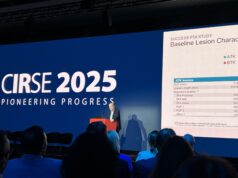
CTO, chronic total occlusion; RCT, randomised controlled trial.
This advertorial is sponsored by Boston Scientific.
Boston Scientific leads the largest clinical programme investigating drug-eluting therapy for the treatment of peripheral arterial disease (PAD), in an effort to capture safety and efficacy data, and to help physicians make informed decisions. PAD affects an estimated 27 million adults in Europe and North America, and is associated with significant morbidity and mortality, as well as impaired quality of life and lower-extremity functioning over time. Boston Scientific’s ELUVIA® drug-eluting stent is a safe, effective option for these patients, writes Yann Gouëffic, MD, PhD (Paris, France).
Endovascular intervention for the treatment of femoropopliteal lesions is established as a first-line strategy. In the 2000s, self-expandable stents showed superiority over percutaneous transluminal angioplasty (PTA), but in-stent restenosis rates were still high (19–37%). Paclitaxel-coated balloons have been shown to successfully prevent intimal hyperplasia, but the use of scaffolding appears to be a more effective option to reduce restenosis.
In 2011, Michael Dake (Tucson, USA) et al evaluated a polymer-free, paclitaxel-eluting stent (ZILVER® PTX®, Cook Medical), and showed that it was superior to balloon angioplasty in terms of patency and reintervention, with provisional stenting. However, there was still room for improvement, notably in terms of controlled drug release: ZILVER® PTX® does not utilise a polymer to release paclitaxel, and delivers approximately 95% of the total drug load within 24 hours of deployment. Paclitaxel levels are sustained in the artery wall for 56 days. However, in-stent restenosis predominantly occurs a year after nitinol stenting in the femoropopliteal segment, so the kinetics of paclitaxel release by ZILVER® PTX® do not match the kinetics of restenosis at the femoropopliteal level.
ELUVIA® is characterised by its nitinol platform (INNOVA®), low paclitaxel loading (0.167μg/mm2 dose density), and use of polymer to control drugelution. The amount of paclitaxel is much lower for ELUVIA® compared with other drug-eluting devices. The polymer is similar to the polymer used in coronary paclitaxel-eluting stents, and, as a result, its safety and biocompatibility have been well studied.
The polymer is composed of a dual layer. The primer layer (poly n-butyl methacrylate) promotes adhesion of the active layer (poly[vinylidiene fluoridehexafluoropropylene]) to the stent, while the active layer controls the release of paclitaxel.
After promising preclinical studies, ELUVIA® was first evaluated in humans in the MAJESTIC registry. In MAJESTIC, 57 patients were treated for femoropopliteal lesions with an average length of 70.8mm±28.1. The primary patency at one year reached 96.4% (Kaplan-Meier [KM] estimate). Subsequently, a randomised (2:1) controlled trial was launched comparing ELUVIA® to ZILVER® PTX® for femoropopliteal lesions: IMPERIAL.
The IMPERIAL trial
The IMPERIAL trial was designed as a non-inferiority study, including patients with Rutherford category 2–4, with lesions that range from 30–140mm in length. Sixty-five centres were included to enrol 465 patients. The primary efficacy endpoint was primary vessel patency at 12 months, defined as a binary endpoint based on a duplex ultrasound peak systolic velocity ratio of 2.4 or lower at the 12-month follow-up visit in the absence of clinically-driven target lesion revascularisation or bypass of the target lesion.
The primary safety endpoint was the occurrence of major adverse events, defined as all causes of death through one month, major amputation of the target limb through 12 months, or target lesion revascularisation (TLR) through 12 months. Additionally, a prespecified post-hoc superiority analysis for the primary efficacy endpoint was included within the statistical analysis plan. A duplex ultrasound core laboratory and a clinical events committee were involved to assess the primary endpoints.
Between December 2015 and February 2017, 309 patients were included in the ELUVIA® group and 156 in the ZILVER® PTX® group. The mean age of participants was 68.5 and 67.8 years old, respectively, and 42–44% of the patients were diabetic. The mean length of the treated lesions ranged from 81.8–86.5mm. Non-inferiority was shown for both efficacy and safety endpoints at 12 months. Primary patency was observed for 231 (87%) of 266 patients in the ELUVIA® group, and for 106 (82%) of 130 patients in the ZILVER® PTX® stent group (difference 5.3% [one-sided lower bound of 95% CI –0.66]; p<0·0001).
Moreover, statistical superiority was met in the post-hoc analysis of 12-month primary patency in the full cohort analysis. Among the secondary endpoints, the rates of thrombosis in the ELUVIA® and ZILVER® PTX® groups were 1.7% and 4%, respectively (p=0.20). One year TLR rates were 4.6% for ELUVIA® and 8.1% for ZILVER® PTX® (p=0.0142). This statistically significant difference is maintained out to two years, with TLR rates of 12.9% and 20.5% for ELUVIA® and ZILVER® PTX®, respectively (p=0.0472).
Prespecified subgroups at high risk of restenosis and reintervention, namely chronic total occlusion (CTO), high calcium lesion, diabetes, and long lesions, were analysed in the IMPERIAL dataset. Lesions at high risk of restenosis demonstrated a consistent two year TLR rate (Figure 1).
In the ELUVIA® group, non-CTO lesions had a higher average one-year primary patency (90.6% vs. 83.9%). Of the 193 lesions considered to have moderate or severe calcifications, a primary patency rate of 89.2% was recorded at one-year compared to lesions with no or mild calcification, which had a patency of 87%. In diabetic patients, ELUVIA® showed primary patency results of 87.4%, consistent with the overall cohort, and in comparison to 80.2% with ZILVER® PTX® at one-year.
Lastly, the 50 long femoropopliteal lesions in IMPERIAL (mean length 162.8mm) had an 87.9% primary patency rate at one year (KM estimate). These data are in line with a previous long femoropopliteal lesion ELUVIA® registry. At one-year, the primary patency rate was 87% (KM estimate). There is remarkable consistency in efficacy across all lesions at high risk of restenosis for this device.
Paclitaxel-coated devices under scrutiny, but benefits outweigh risks
In December 2018, a meta-analysis showed a late mortality signal with certain paclitaxel-coated devices compared to non-coated devices. Notably, the ELUVIA® stent was not included in this. Recently, a new meta-analysis was presented at the FDA Panel in June 2019, though, again, ELUVIA® was not part of these contributing datasets.
However, during this June meeting, additional data were released regarding the comparison between ELUVIA® and coronary drug-eluting stent designs. Interestingly, the polymer release design principles are similar between both, but paclitaxel concentration is higher in coronary paclitaxel-eluting stents. Over 4,000 patients have been included in randomised clinical trials comparing paclitaxel-eluting coronary stents versus bare metal stents, and no all-cause mortality signal has been observed in a meta-analysis, negating the hypothesis of a systemic effect of paclitaxel delivered by this method. The FDA highlighted “that for individual patients judged to be at particularly high risk for restenosis and repeat femoropopliteal interventions, clinicians may determine that the benefits of using a paclitaxel-coated device outweigh the risk of late mortality”.
Boston Scientific has developed the largest clinical programme regarding drug-eluting therapy for PAD. The EMINENT RCT is recruiting 750 patients to compare ELUVIA® to bare-metal stents. To ensure long-term data capture both IMPERIAL and EMINENT, follow-up has been extended to five years. SPORTS, an investigator-sponsored study, is an RCT with three arms (total 222 patients) to compare a bare metal stent, a paclitaxel-eluting stent, and a paclitaxel-coated balloon (SeQuent Please®, from B Braun) for long femoropopliteal lesions.
Data from this clinical programme, as well as from other ongoing drug-eluting device trials and analyses, should provide further information to help physicians with patient-centric decision-making in the endovascular treatment of femoropopliteal disease, and in particular the treatment of lesions at high risk of restenosis.
Yann Gouëffic, MD, PhD, is affiliated with the department of vascular and endovascular surgery, Hôpital Paris St Joseph, Paris, France.










